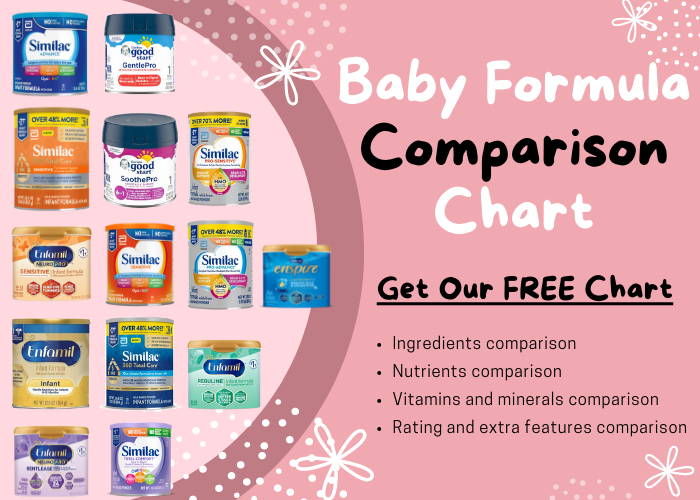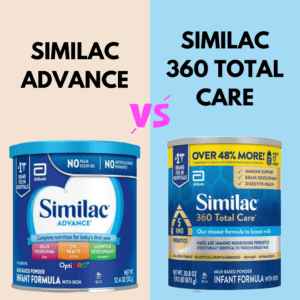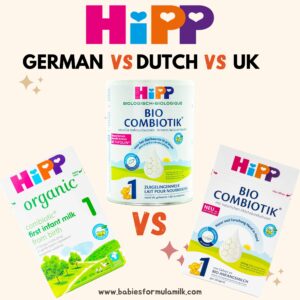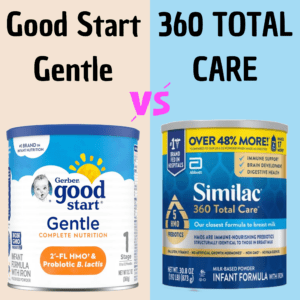Similac Advance and Similac Sensitive cater to distinct baby needs, and their differences lie in formula suitability, protein sources, and additional components:
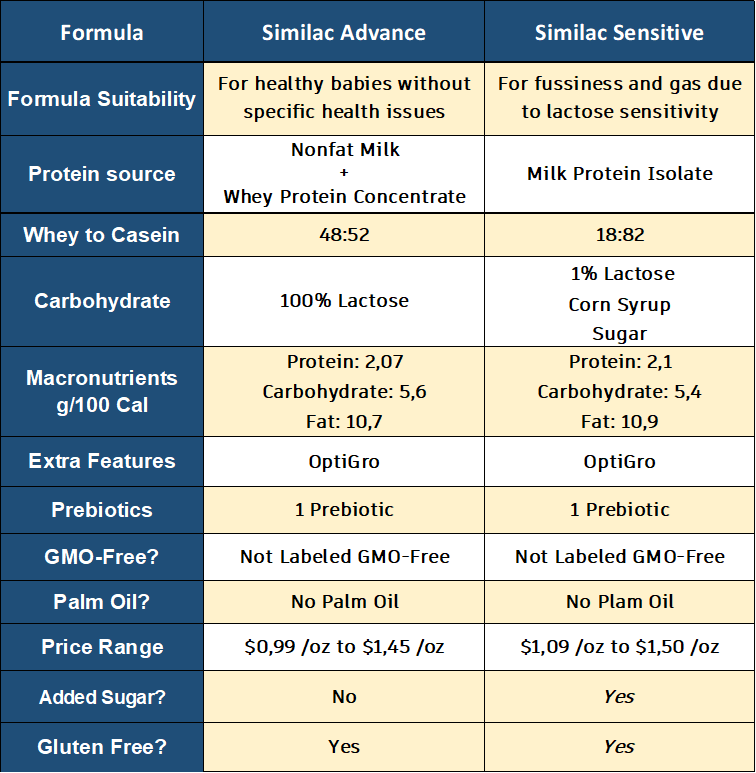
Similac Advance is designed for healthy infants without specific health issues, featuring a protein blend of nonfat milk and whey protein concentrate in a 48:52 whey-to-casein ratio. Its carbohydrate content consists of 100% lactose, and it is free from added sugars. Priced between $0.99/oz to $1.45/oz, Similac Advance is gluten-free. On the other hand, Similac Sensitive targets infants dealing with fussiness and gas due to lactose sensitivity. Its protein source is milk protein isolate with an 18:82 whey-to-casein ratio. Carbohydrates include 1% lactose, corn syrup, and sugar. Priced between $1.09/oz to $1.50/oz, Similac Sensitive is also gluten-free but contains added sugars.
Which One to Choose?
The choice between Similac Advance and Similac Sensitive ultimately depends on your baby’s specific needs and any potential health considerations:
Choose Similac Advance if:
- Your baby is healthy without specific health issues.
- You prefer a formula with a whey-to-casein ratio close to breastmilk.
- Your baby does not have a lactose sensitivity, as Similac Advance’s carbohydrate source is 100% Lactose.
- You appreciate the inclusion of OptiGro for additional nutritional support.
- Your budget allows for a slightly lower price range of $0.99/oz to $1.45/oz.
- You prioritize a formula without added sugar, and gluten-free options are essential.
Choose Similac Sensitive if:
- Your baby experiences fussiness and gas due to lactose sensitivity.
- You prefer a formula with higher casein and lower whey protein.
- Your baby may benefit from a formula with a reduced lactose content (1%) along with corn syrup and sugar as carbohydrate sources.
- The inclusion of OptiGro is important to you for additional nutritional support.
- The presence of added sugar is acceptable, and you prioritize gluten-free options.
Mom’s Reviews and Experiences:
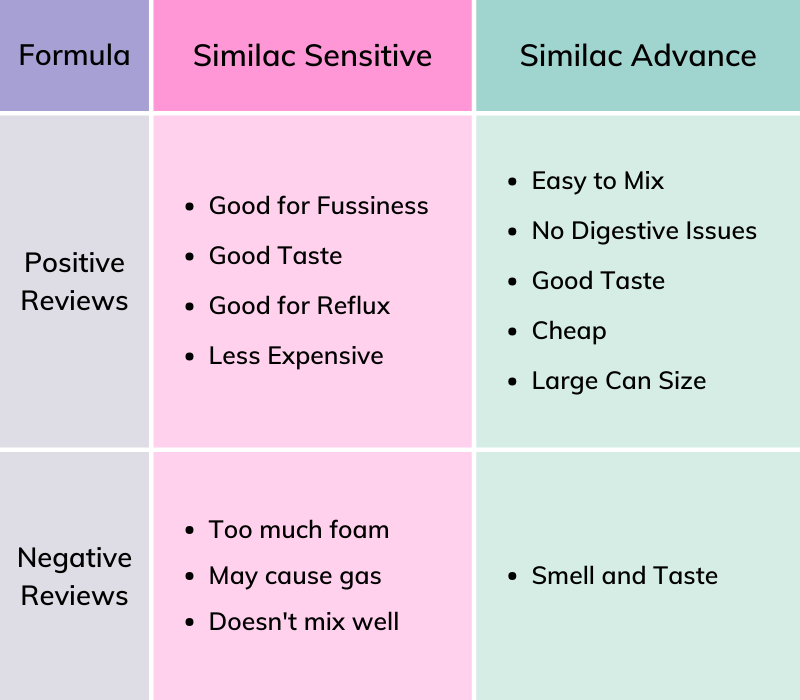
Similac Sensitive:
Similac Sensitive has received positive acclaim from mothers who find it particularly effective in addressing fussiness and reflux due to its lactose-reduced profile of 99%. The reduction in lactose makes it a suitable option for babies with sensitivities, earning it appreciation for its targeted formulation.
Additionally, mothers praise its good taste because of the added sugar, making it more appealing for infants. Affordability is another key positive aspect, with Similac Sensitive being perceived as less expensive compared to other formulas designed for sensitive tummies. However, negative reviews indicate concerns about excessive foam, potential gas issues, and difficulties in achieving a well-mixed consistency.
Similac Advance:
Similac Advance, according to positive reviews, stands out for its ease of mixing, providing convenience for parents during bottle preparation. The absence of reported digestive issues adds to its appeal, assuring parents of their baby’s comfort. The formula is also noted for its good taste, making it more likely that infants will accept it willingly.
Moreover, it is perceived as cost-effective when compared to other standard milk-based formulas, offering affordability without compromising on quality. However, a few negative reviews have raised concerns about the smell and taste of the formula.
Ingredients Breakdown:

Age Range:
Both formulas are formulated for infants aged 0-12 months, covering the crucial early stages of development.
Protein Source:
Similac Advance incorporates a combination of Nonfat Milk and Whey Protein Concentrate. The inclusion of whey protein is known for its high-quality and easily digestible nature, making it suitable for the delicate digestive systems of infants.
Similac Sensitive, on the other hand, utilizes Milk Protein Isolate, a protein source that is gentler on babies with lactose sensitivity. This choice aims to address potential protein-related discomfort in certain infants.
Milk Protein Isolate (MPI) is a concentrated form of milk protein that has undergone processing to isolate and extract its protein content. It is derived from milk, which contains two primary types of proteins: whey and casein. The isolation process involves removing most of the non-protein components, including minerals and lactose.
Whey to Casein Ratio:
Similac Advance maintains a whey to casein ratio of 48:52, which mimics the ratio found in breast milk. This balanced composition provides a mix of fast-digesting whey and slow-digesting casein, contributing to better digestion and nutrient absorption.
Similac Sensitive, with its lower whey content and a ratio of 18:82, adjusts the protein composition to potentially alleviate digestive concerns associated with lactose sensitivity.
Carbohydrate Composition:
Similac Advance relies on 100% Lactose as its carbohydrate source. Lactose is a natural sugar found in breast milk, providing a well-tolerated energy source for most infants.
Similac Sensitive takes a nuanced approach by combining 1% Lactose with Corn Syrup and Sugar. This blend aims to cater to babies with sensitivity to higher lactose content while maintaining a carbohydrate profile that supports healthy development.
Fat Source:
Both formulas share a similar fat source, including High Oleic Safflower Oil, Soy Oil, Coconut Oil, and DHA/ARA (Docosahexaenoic Acid/Arachidonic Acid). These fats are carefully chosen to mimic the fat composition found in breast milk, crucial for brain and visual development in infants.
Extra Features:
OptiGro, present in both formulas, is a blend of key nutrients like DHA, important for brain and eye development; Lutein, promoting healthy vision; and Vitamin E, an antioxidant. OptiGro aims to mimic the nutritional composition of breast milk, providing a comprehensive and balanced source of essential elements for infant growth and development.
Furthermore, Short-chain Fructooligosaccharides serve as prebiotics in both formulas. These prebiotics promote the growth of beneficial gut bacteria, contributing to a healthy digestive system.
Generic Brands:
Similac Advance is associated with 9 generic brands, providing a range of options for parents who want to opt for more affordable alternatives. These generic brands aim to offer cost-effective solutions while maintaining nutritional standards. Read Best 9 Generic Similac Advance formulas.
Similac Sensitive has 7 associated generic brands, giving parents flexibility in choosing alternatives that align with their budget constraints while ensuring the nutritional needs of their infants are met. Read Best 7 Generic Similac Sensitive formula.
Source of ARA (Arachidonic Acid):
Both formulas utilize Mortierella alpina oil as a source of ARA. ARA is a vital component for the structural development of the brain, nerves, and eyes in infants.
Source of DHA (Docosahexaenoic Acid):
Similac Advance sources DHA from Schizochytrium sp. oil, while Similac Sensitive uses Crypthecodinium cohnii oil. These are plant-based sources of DHA, contributing to the essential omega-3 fatty acids necessary for optimal brain and visual development.
Nutritional Profiles:
Macronutrients and Vitamins:

Both formulas are pretty similar when it comes to their nutrients. They have a tiny difference in protein, where Similac Sensitive has a bit more (2.1g) compared to Similac Advance (2.07g). The fat levels are a bit different too, with Similac Advance having 5.6g and Similac Sensitive having 5.4g. The carbohydrate levels also have a small gap, with Similac Advance at 10.7g and Similac Sensitive at 10.9g. These slight differences are because Similac Sensitive has a different source of protein and carbohydrate. But here’s the good part – both formulas have the same important vitamins, like Vitamin B12, which is super important for a baby’s development.
Minerals:
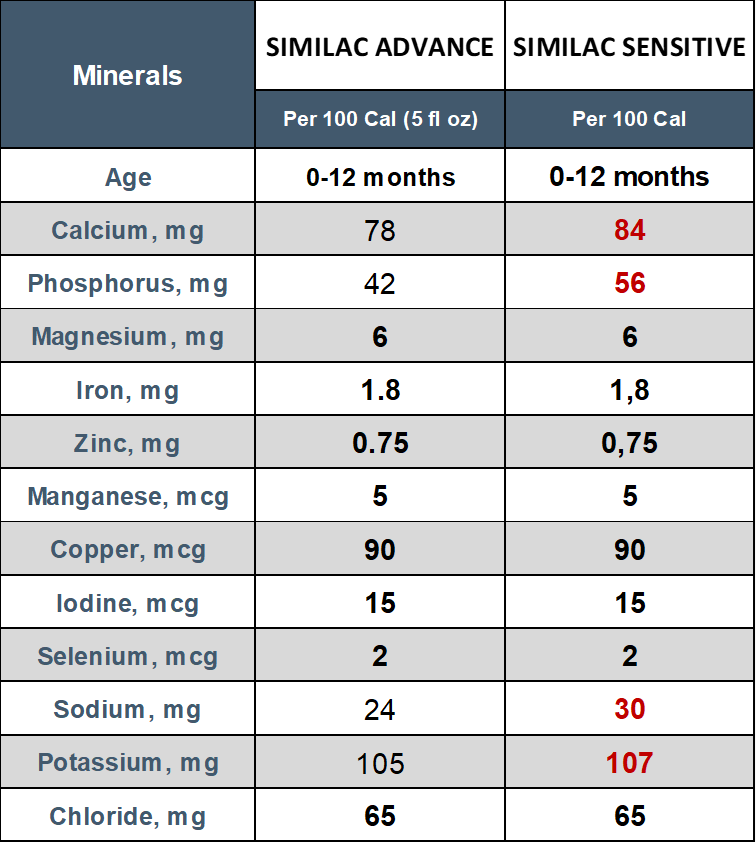
Similac Advance and Similac Sensitive share quite similar mineral compositions, but there are some subtle differences to note. Similac Sensitive has a slightly higher calcium content at 84mg compared to Similac Advance’s 78mg, potentially contributing a bit more to bone and teeth development. When it comes to phosphorus and sodium it takes also the lead, these minerals positively impact bone and cell structure and play a role in fluid balance and nerve function respectively.
Iron levels are consistent in both formulas at 1.8mg, ensuring proper prevention of anemia and supporting cognitive development.
Potassium levels are quite similar, with Similac Advance at 105mg and Similac Sensitive at 107mg, both crucial for heart health and muscle function.
Price Analysis:
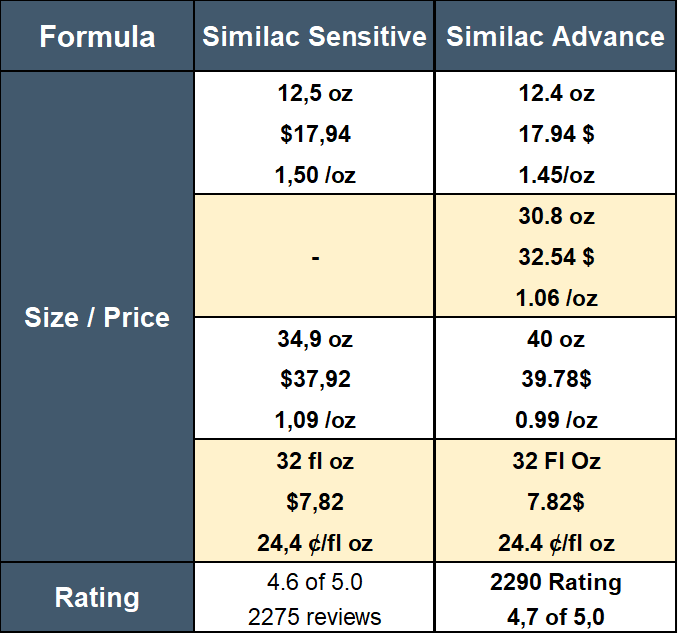
When considering the cost-effectiveness, several factors come into play. Similac Advance generally has a slightly lower cost per ounce in larger sizes compared to Similac Sensitive. For instance, the 40 oz size of Similac Advance is priced at $39.78 with a cost per ounce of $0.99, while Similac Sensitive’s 34.9 oz size is priced at $37.92 with a cost per ounce of $1.09. The difference in price per ounce is relatively small but may accumulate over time, especially for parents who purchase formula regularly.
However, it’s essential to consider the unique needs of your baby. If lactose sensitivity is a concern, Similac Sensitive will be the preferred choice, despite a slightly higher cost per ounce. On the other hand, if your baby doesn’t have specific sensitivity concerns, it’s not worth buying Similac Sensitive.
Customer satisfaction ratings also play a role in decision-making. Both formulas have high ratings, with Similac Advance slightly edging out Similac Sensitive. Parent reviews offer insights into factors like taste, mixing ease, and overall satisfaction.
Alternatives to Similac Advance:
There are several alternatives to Similac Advance, and the choice depends on your baby’s specific needs and your personal preferences. Here are a few alternatives to Similac Advance:
Enfamil Infant:
Enfamil is a well-known formula brand with a variety of options. Enfamil Infant is designed to be closer to breast milk, providing essential nutrients for your baby’s growth and development.
Gerber Good Start Gentle:
Gerber offers a Gentle formula designed to be easy on your baby’s tummy. It contains Comfort Proteins that are easy to digest and supports a gentle transition from breast milk or another formula.
Similac Pro-Advance:
The closest alternative within the Similac range is Similac Pro-Advance. It includes 2′-FL Human Milk Oligosaccharide (HMO), which is an immune-nourishing prebiotic found in breast milk. Read Similac Advance Vs. Similac Pro Advance.
Earth’s Best Organic Infant Formula:
If you prefer an organic option, Earth’s Best offers an organic infant formula. It is made with high-quality organic ingredients and aims to provide balanced nutrition for your baby.
HiPP Combiotic:
HiPP Combiotic formula Contains a combination of probiotics and prebiotics to support a baby’s gut health. HiPP formulas are known for their use of organic ingredients, strict quality control, and adherence to European organic farming standards. They are free from synthetic pesticides, herbicides, and genetically modified ingredients. Read HiPP Combiotic VS Similac: Which One is The Best?
Alternatives to Similac Sensitive:
If you’re considering alternatives to Similac Sensitive, there are various formulas on the market designed for babies with fussiness and gas due to lactose sensitivity or other digestive issues. Here are some alternatives:
Similac Pro-Sensitive:
The closest alternative in the Similac range is Similac Pro-Sensitive because they are similar except for a few differences. It contains 2′-FL Human Milk Oligosaccharide (HMO), promoting immune support. Read Similac Sensitive Vs Similac Pro Sensitive.
Similac 360 Total Care Sensitive:
Another alternative in the Similac brand, it is Non-GMO and has also milk protein isolate as a protein source, 2% lactose and corn syrup solids plus sugar, and is fortified with 5 HMO prebiotics. Read Similac Sensitive Vs. 360 Total Care Sensitive.
Enfamil Sensitive:
Enfamil Sensitive, with a 1% lactose and milk protein isolate, is designed for infants with moderate lactose sensitivity, ensuring easy digestion while maintaining essential nutrients. It has the MFGM feature and the 2′-FL HMO prebiotic. Read Enfamil Sensitive Vs Similac Sensitive.
Similac Total Comfort:
Similac Total Comfort is 100% whey partially hydrolyzed and lactose-reduced by 99%, addressing gas, colic, and promoting regular bowel movements. Read Similac Sensitive Vs. Similac Total Comfort.


